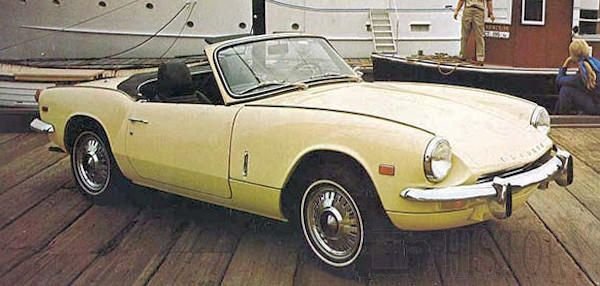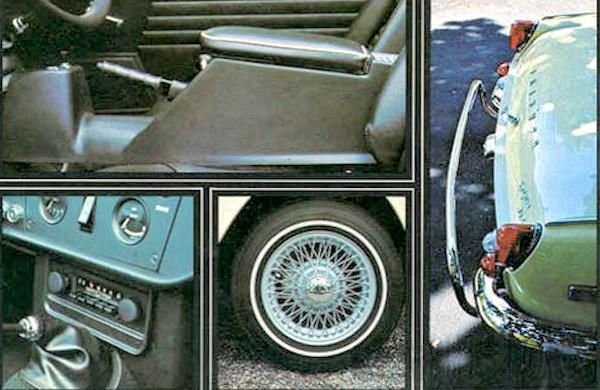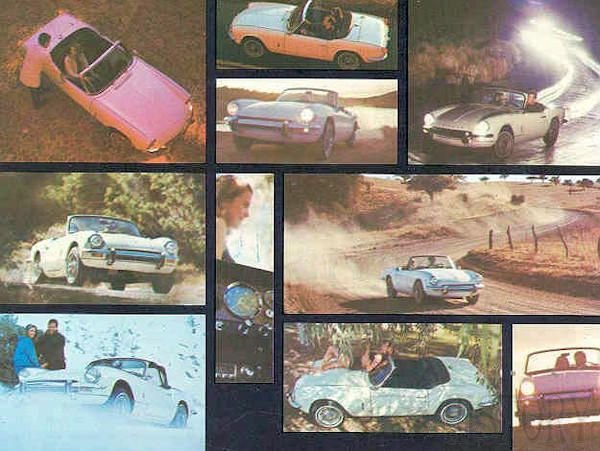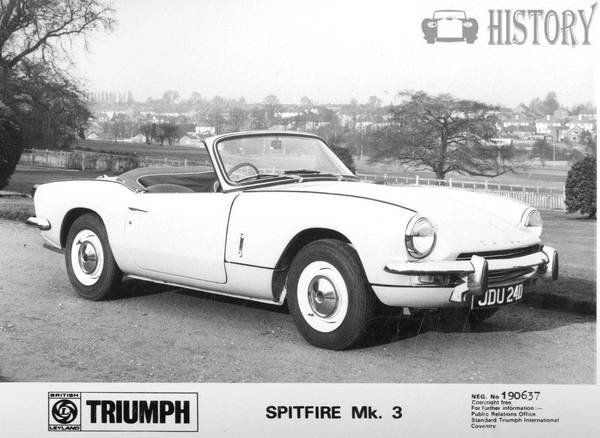Triumph Spitfire Mark III
| 1967 to 1970 | |
|---|---|
 |
|
| Overview | |
| years | 1967 to 1970 |
| Produced | 65,320 made |
| Class | Sports car |
| Body | Roadster |
| Powertrain | |
| Engine | 1,296 cc (1.3 l) I4 |
| Transmission | 4-speed manual with optional overdrive on top and third |
| Dimensions | |
| Curb weight | 1,430 1b, 648 kg |
| wheel base | 83 in, 2,108 mm |
| overall length | 147 in, 3,734 mm |
| overall width | 57 in, 1,448 mm |
| overall height | 47.50 in, 1,206 mm |
| ground clearance | 5 in, 127 mm |
The Mark III, introduced in March 1967, was the first major facelift to the Spitfire. The front bumper was raised in response to new crash regulations, and although much of the bonnet pressing was carried over, the front end looked quite different. The rear lost the overriders from the bumper but gained reversing lights as standard (initially as two separate lights on either side of the number plate, latterly as a single light in a new unit above the number plate); the interior was improved again with a wood-veneer instrument surround. A folding hood replaced the earlier "build it yourself" arrangement. For most of the Mark III range, the instrument cluster was still centre-mounted (as in the Mark I and Mark II) so as to reduce parts bin counts (and thereby production costs) for right-hand and left-hand drive versions.Options wire wheels; servo brakes and hardtop.
The chassis a double backbone type, with channel section with outriggers with cars distribution of weight was 56% to front axle, and 44% at rear axle. the front suspension was independent, wishbones, coil springs, anti-roll bar and telescopic dampers,the rear independent, swinging semi-axles, transverse leafspring upper arms, swinging longitudinal trailing arms with telescopic dampers.

The 1147 cc engine was replaced with a bored-out 1296 cc unit (the bore increasing from 69.3 mm (2.73 in) to 73.7 mm (2.90 in), stroke retained at 76 mm (3.0 in)), as fitted on the new Triumph Herald 13/60 and Triumph 1300 saloons. In SU twin-carburettor form, the engine put out a claimed 75 bhp (56 kW), and 75 lb·ft (102 N·m) of torque at 4000 rpm, and made the Mark III a comparatively quick car by the standards of the day.Popular options continued to include wire wheels, a hard top and a Laycock de Normanville overdrive, and far more relaxed and economical cruising at high speeds. The Mark III was the fastest Spitfire yet, achieving 60 mph (97 km/h) in 14.5 seconds, and reaching a top speed of 95 mph (153 km/h). Average fuel consumption was improved slightly at 33mpg. The Mark III actually continued production into 1971, well after the Mark IV was introduced.
PERFORMANCE
- engine capacity 79.08 cu in, 1,296 cu cm
- fuel consumption 33 m/imp gal, 27.7 m/US gal, 8.5 1 x 100 km
- max speed 103 mph, 165.8 km/h max speed in overdrive/top 91 mph, 146.5 km/h.
- max power (DIN): 76 hp at 6,000 rpm
- max torque (DIN): 90 1b ft, 12.4 kg m at 4.000 rpm
- max engine rpm: 6,700
- specific power: 58.6 hp/l
- power- weight ratio: 17.8 lb/hp, 8.5 kg/hp
- acceleration standing 1/4 mile 18.5 sec, 0—50 mph (0—80 km/h) 9 sec
On 8 February 1968, Standard-Triumph General Manager George Turnbull personally drove the 100,000th| Triumph Spitfire off the end of the Canley production line. More than 75 per cent of the total production had been exported outside the UK, including 45 per cent to the USA and 25 per cent to mainland European markets.
Starting in 1969, however, US-bound models had to be changed to comply with new safety/emission regulations; models produced after 1969 are sometimes referred to as "federal" Spitfires. The changes resulted in a slight decrease in power (68 bhp) due to emissions control, the instrument panel was moved in front of the driver, and new seats were introduced with integrated headrests to help against whiplash. Also the wood dash was replaced with a matte black finish.

History
The Triumph Spitfire is a small English two-seat sports car, introduced at the London Motor Show in 1962. The vehicle was based on a design produced for Standard-Triumph in 1957 by Italian designer Giovanni Michelotti. The platform for the car was largely based upon the chassis, engine, and running gear of the Triumph Herald saloon, and was manufactured at the Standard-Triumph works at Canley, in Coventry. As was typical for cars of this era, the bodywork was fitted onto a separate structural chassis, but for the Spitfire, which was designed as an open top or convertible sports car from the outset, the ladder chassis was reinforced for additional rigidity by the use of structural components within the bodywork. The Spitfire was provided with a manual hood for weather protection, the design improving to a folding hood for later models. Factory-manufactured hard-tops were also available.
The Triumph Spitfire was originally devised by Standard-Triumph to compete in the small sports car market that had opened up with the introduction of the Austin-Healey Sprite. The Sprite had used the basic drive train of the Austin A30/35 in a light body to make up a budget sports car; Triumph's idea was to use the mechanicals from their small saloon, the Herald, to underpin the new project. Triumph had one advantage, however; where the Austin A30 range was of unitary construction, the Herald featured a separate chassis. It was Triumph's intention to cut that chassis down and clothe it in a sports body, saving the costs of developing a completely new chassis / body unit.
Italian designer Michelotti—who had already penned the Herald—was commissioned for the new project, and came up with a traditional, swooping body. Wind-up windows were provided (in contrast to the Sprite/Midget, which still featured sidescreens, also called curtains, at that time), as well as a single-piece front end which tilted forwards to offer unrivalled access to the engine. At the dawn of the 1960s, however, Standard-Triumph was in deep financial trouble, and unable to put the new car into production; it was not until the company was taken over by the Leyland organization funds became available and the car was launched. Leyland officials, taking stock of their new acquisition, found Michelotti's prototype hiding under a dust sheet in a corner of the factory and rapidly approved it for production.
Technical
-
Triumph Spitfire Mark III Technical details and specifications (1967-1970)
ENGINE
location front, 4 stroke
cylinders: 4, vertical, in line
bore and stroke: 2.09 x 2.99 in. 73.7 x 76 mm
engine capacity: 79.08 cu in, 1,296 cu cm
compression ratio: 9
cylinder block: cast iron
cylinder head: cast iron
crankshaft bearings: 3
valves: 2 per cylinder, over-head. in line, push-rods and rockers
camshafts: 1, Side
lubrication: rotary pump, full now filter
carburation: 2 SU type HS 2 semi-downdraught carburettors
fuel feed: mechanical pump
cooling system: liquid, sealed circuitTRANSMISSION
driving wheels: rear
clutch: single dry plate, hydraulically controlled
gearbox: mechanical; gears: 4+ reverse
synchromesh gears: 2nd, 3rd,4th
gearbox ratios: I 3.747, II 2.158, III 1.394, IV 1, rev 3.750
(option) Laycock-de Normanville overdrive on 3rd and 4th (0.280 ratio)
gear lever location: central
final drive: hypoid bevel
axle ratio: 4.110 (option) 3.750
CHASSIS
type double backbone, channel section with outriggers
front suspension: independent, wishbones, coil springs, anti-roll bar, telescopic dampers
rear suspension: independent, swinging semi-axles, transverse leafspring upper arms, swinging longitudinal trailing arms, telescopic dampers.STEERING
rack-and-pinion
turns of steering wheel lock to lock: 3.75.
turning circle (between walls): 24 ft, 7.3 mBRAKES
front disc (diameter 9 in, 229 mm), rear drum
area rubbed by linings: front 197 sq in, 1,270.65 sq cm
area rubbed by linings: rear 67 sq in, 432.15 sq cm
area rubbed by linings: total 264 sq in, 1,702.80 sq cm.ELECTRICAL EQUIPMENT
voltage: 12 V
battery: 43 Ah
generator type: dynamo, 264 W
ignition distributor: LucasDIMENSIONS AND WEIGHT
wheel base: 83 in, 2,108 mm
front track: 49 in, 1,245 mm
rear track: 48 in, 1,219 mm
overall length: 147 in, 3,734 mm
overall width: 57 in, 1,448 mm
overall height: 47.50 in, 1,206 mm
ground clearance: 5 in, 127 mm
dry weight: 1,430 1b, 648 kg
distribution of weight: 56% front axle, 44% rear axle© Motor car History
Service
-
Triumph Spitfire Mark III Maintenance and Service Guide (1967-1970)
Fuel: 100 oct petrol
Engine oil change: 8 imp pt, 9.51 US pt, 4.5 1, SAE 20, change every 6,000 miles, 9,700 km
Max lubricating system capacity: 8.40 imp pt, 10.15 US pt, 4.8 1
Cooling system capacity: 7.90 imp pt. 9.51 US pt
Gearbox oil: 1.5 imp pt, 1.69 US pt, 0.8 1, SAE 90
Final drive oil: 1 imp pt. 1.27 US pt. 0.5 1, SAE
Greasing : every 6,000 miles, 9,700 km, 2 points, every 12,000 miles, 19,300 km, 2 points
Tappet clearances: inlet 0.010 in, 0.25 mm, exhaust 0.010 in, 0.25 mm
Valve timing: inlet opens 18° before tdc and closes 58° after bdc, exhaust opens 58° before bd and closes 18° after tdc
Normal tyre pressure: front 18 psi, 1.3 atm, rear 24 ps 1.7 atm.
Width of rims: 3.5"
Tyres: 5.20 x 13
Fuel tank capacity: 8.5 imp gal, 10.3 US gal
Carrying capacity: 353 1b, 160 kg© Motor car History

